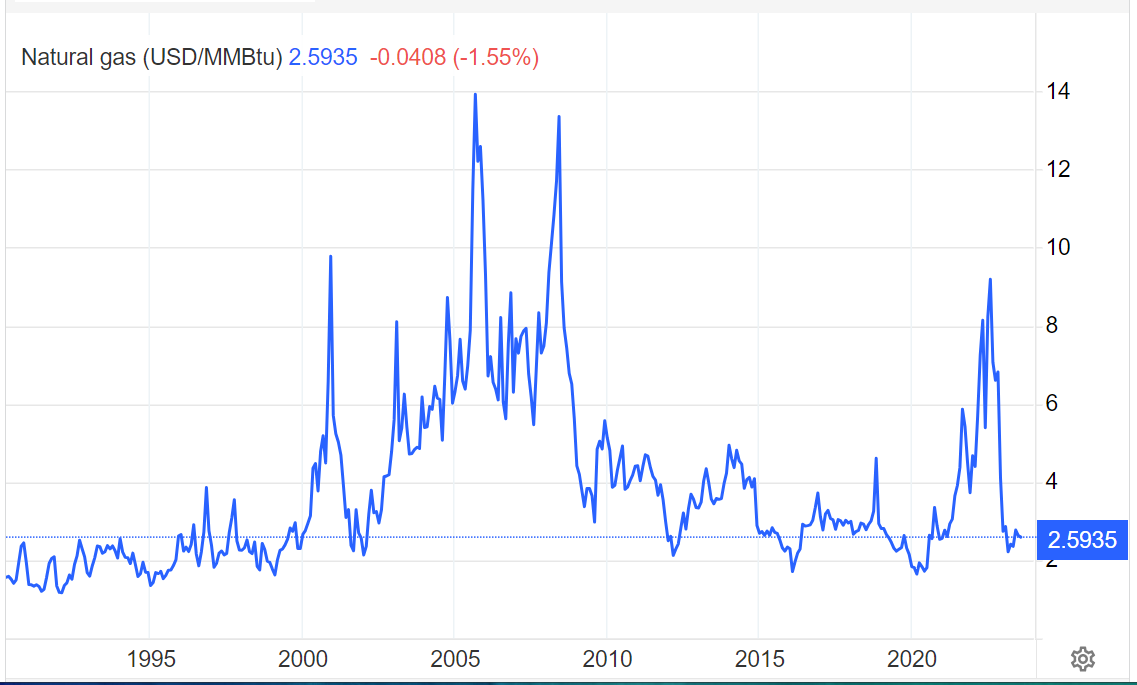Welcome to Episode 91 of Special Situation Investing.
I recently listened to the podcast Forward Guidance with Jack Farley, titled Rate Cuts May Not End Fed's Quantitative Tightening. The podcast is an interview with former Atlanta Fed President Dennis Lockhart. What struck me most about the interview was not the content itself but the broad generalities used by central bankers to describe their craft and the fact that they seem to believe that economies are cause and effect machines that can be managed. Consider the following quote from Mr. Lockhart wherein he recalls the meeting that led to the Federal Reserve’s adoption of a 2% inflation target.
Explicitly stating a 2% target for inflation helped to anchor inflation expectations and inflation expectations are a factor in inflation. It’s important that the public not believe that inflation is going to get out of hand and therefore change their consumption patterns for that reason.
Listening to those two sentences of the interview generated about a dozen questions in my mind. What exactly is a 2% inflation target? To meet the target would inflation have to be exactly 2%, or an average of 2%? If we’re targeting an average of 2%, then over what time period must we measure inflation to know that our target was achieved? Which measure of inflation should we use and can the measuring tool itself change over time, as it has in the past? What is the cause of inflation, is it consumer expectations, consumption patterns, supply chain imbalances or some other mysterious force or combination of forces?
In the early 1930’s, Alfred Corzybski wrote Science and Sanity: An Introduction to Non-Aristotelian Systems and General Semantics and launched the concept of General Semantics into the world. One of the ideas contained in Corzybski’s work was the idea that much of our language is undefinable and that this lack of linguistic precision leads to confusion in both thought and communication.
We can see a few examples of this imprecise language in the quotation already cited in this write-up. For example, how would you strictly measure “inflation expectations?” By what degree must the populace expect there to be inflation, how much inflation does each person need to expect, and over what time period do you measure changes in expectations? Can consumer expectations of deflation cause the opposite phenomenon to occur?
Speaking in generalities carries a double benefit to the speaker in that it sounds like something significant is being communicated, even when it isn’t, and it’s very generality gives it the appearance of prescience in hindsight. If the rate of inflation returns to two percent then the federal reserve looks brilliant and if it doesn’t, well, they told you it wouldn’t because public inflation expectations ran too high. Or worst case, if the inflation rate stays well above or below their target for years, then we simply haven’t waited long enough for the average inflation rate to hit our desired target. Any future outcome, will look in hindsight as though it were predicted in advance.
The second aspect of Mr. Lockart’s statement that caught my attention, was his belief that the Fed can manage the economy. His argument is, by anchoring inflation expectations at 2% the public will not adjust their expectations upward. We, at this podcast, believe that the economy is a complex adaptive system more akin to an ecosystem than a diesel generator, but some, to include most economist and central bankers, operate from the “economy-as-a-machine” framework.
The best example of the “economy-as-a-machine” perspective is probably Ray Dalio’s video titled, How the Economic Machine Works. The video is well produced and educational and hits on all the ways in which the economy does, in fact, work like a machine, but it fails to address the ways in which the economy also functions like a complex adaptive system.
A complex adaptive system, is a system made up of many individual parts or agents. The individual parts, or agents, in a complex adaptive system follow simple rules and there is no leader or individual who is coordinating the action of others. The key word in that definition is, agents. Agents decide, agents act independently, agents are more than simple cause and effect parts of a machine.
If a diesel generator is about to run out of fuel it can’t decide preemptively to throttle back and conserve fuel or to shut itself down and save some fuel for the future but an individual, an agent, can. Each agent within an economy can respond, using their own agency, to any signal in whichever way they see fit. Ludwig von Mises, expounds on this concept extensively in his book Human Action, using the term praxeology to frame the idea.
Listening to Mr. Lockart’s interview and reflecting on his mechanistic economic views, supported by all the vaguery that the English language could bring to bear on the topic, served to highlight the contrast between his economic framework and my own. My own view is that the economy functions more like a natural habitat than a washing machine.
Practically speaking, this perspective has left me with a “keep it simple stupid” view of investing. If I don’t believe the economy is a machine, which I don’t, then I won’t fool myself into thinking I can predict where the economy is going. Instead, I can take each investment opportunity independently and judge for myself how the investment will perform under all types of economic environments.
I don’t dilute myself into thinking that I can predict which specific economic conditions the investment will face but I do run through a variety of scenarios that the investment could face. Humans follow the same reasoning when preparing for adverse weather. Rather than spend time attempting to predict the exact time and location of a tornado, we spend the time and effort building a storm shelter so that if a tornado comes we can deal with it, regardless of whether or not we accurately forecasted the tornado itself. Approaching investing in this way leads you to make investments based on a few very clear signals that cut through the noise that would otherwise confuse your thinking.
Speaking from my own experience, this view of the world has led to some of my best performing investments. To this day, I still have the piece of hotel stationary on which I penciled out my decision to buy Monster Energy stock. I had some down time at my hotel while traveling for work and decided to do a very basic discounted cash flow table of what I predicted Monster Energy would earn over the next ten years.
The ten-year-out date is now years in the past but the earnings estimates were pretty close to the actual numbers that the company produced. My buy thesis rested on the following few premises: that caffeine and sugar are habit forming, that the company was founder-led with high insider ownership, that the company had a low-cost structure, and that the addressable market still had plenty of runway. On the opposite end of the spectrum, I’ve had some pretty fancy investment theses in other companies that resulted, predictably, in poor investment results.
The acknowledgement that we can’t control or predict where the economy is going should lead us down a pathway to more simple, not more complicated, investments. Today’s investment write-up is as simple as they come.
San Juan Basin Royalty Trust
San Juan Basin Royalty Trust (SJT) and Permian Basin Royalty Trust (PBT) were created from the same transaction in 1980. A 75% net overriding royalty was conveyed to San Juan Basin Trust on 156,000 gross acres of northern New Mexico land. The land produces predominantly natural gas with some oil included in overall production. The Trust’s land ownership is fee simple and the trust has no set end date.
With a current market cap of $358 mm, the Trust was able to produce $7 mm in earnings in 2020 and $78 mm in 2022. 2020 was, of course, the worst year possible for Oil and Gas as the entire industry ground to a halt due to COVID lockdowns. That the Trust earned anything at all is a testament to the superior economics of royalties and trusts.
So there it is, as simple as a lemonade stand, but if it’s that simple, then why write about it at all? To begin, that’s why we had the long introduction explaining our obsession with simple investment thesis. A thesis so simple that they can be penciled onto a piece of hotel stationary in less than an hour. That, and there is a little more to our thesis than just that overview.
First of all, lets review SJTs past performance. From 1995 (the earliest date I could get comparison data for) through today, SJT kept pace with the S&P 500 delivering a 9.3% versus 9.5% CAGR, with dividends reinvested, over the 28 year period.
On the surface this appears unremarkable but consider the macro environment the Trust faced during that time period. In August of 1995, natural gas sold for $2.18 per MMBtu and in 2023 it was priced at $2.66 per MMBtu. There were price spikes along the way but overall the price of natural gas was flat.
Remember that a trust is a pass through vehicle with no mechanism for management brilliance to save the organization from economic headwinds. That the trust kept pace with the index despite a flat pricing environment is really quite remarkable. Consider that a one day ticket to Disneyland cost $35 in 1995 and $109-$189 today…depending on the date you visit. Imagine how Disney stock would have faired had the ticket price remained nearly flat for close to 30 years. The “magic kingdom” probably could not have survived as a public company under those conditions but the magic in a trust like SJT is that its extremely low cost structure allows it to keep pace with the some of the best CEOs in the world without even trying.
The future, of course, may not play out like the past, but the past does provide us with a useful case study. Because the pricing environment was so bad over the last several decades, to include a year of negative oil futures prices in 2020, we have a worst case baseline environment from which to judge the Trust’s return on investment and the performance, all things considered, is adequate.
As we’ve discussed in prior episode, we may be going into a period of sustained and higher inflation within which a pass through trust like SJT would outperform its higher cost structure competitors, but because we’re not betting the farm on macro economic forecast, all we can say is that the performance going forward should be somewhere between adequate and outstanding. In either case, we’re taking very little risk to participate in this perpetual call option on the future of oil and gas.
There is another point worth touching on, one that further informs our valuation thesis. We’ve discussed the point in previous writeups so this will be a bit of a review, but it is a point well worth repeating. SJT’s land ownership is fee simple meaning that it owns the underlying property and mineral rights and not just a right to specific wells.
Any given oil and gas well’s production will decline over time but the productivity of a piece of land, with many well sights on it, can extend out for decades. This was a point of confusion for us when we first started to research companies in the oil and gas space. When we saw proved reserves stated in a 10k, we took the numbers at face value and assumed it was an estimate of the property’s total oil content but that turns out not to be the case.
The society of petroleum engineers defines proved reserves as:
Those quantities of petroleum which, by analysis of geological and engineering data, can be estimated with reasonable certainty to be commercially recoverable, from a given date forward, from known reservoirs and under current economic conditions, operating methods, and government regulations.
Put simply, oil reserves are not the actual amount of oil in the ground. Rather, they are the amount of oil that can be reasonably believed to be recoverable given today’s oil price, technology, available extraction equipment on the property, and government regulation. The definition includes several variables all of which are in constant flux.
The point can be clarified by reviewing the following actual oil and gas reserves of SJT beginning in 1992, the earliest date I could get reliable information, through 2022. To keep the table manageable, it includes only even years.
A casual review of the numbers illustrates the point that reserves are not an assessment of oil in the ground. If that were the case the highest numbers would appear in 1992 and would steadily decline with each passing year. The numbers, however, don’t follow that pattern but rather start high, then decline, then rise, and then continue up and down over the years. The best correlation I could find between the proved reserves for SJT and any other chart was to compare the chart to the price of natural gas over the same time period. Reserves are higher when the price is high and they are low when the price declines.
Of course there is more to it than a simple price correlation as technological improvements like fracking increase reserve estimates as does increased infrastructure on the property. The point of all of this is simply to illustrate that a very high free cash flow yield can be obtained on a debt free asset with almost no expenses by buying SJT and that reserves could last for much longer than any superficial review of the companies 10k would lead you to believe.
Well, with that we’ve come to the end of another episode. Again we thank you for all the support, especially the Boosts on Fountain podcast app. We look forward to bringing you another episode with more actionable write-ups next week.














Share this post